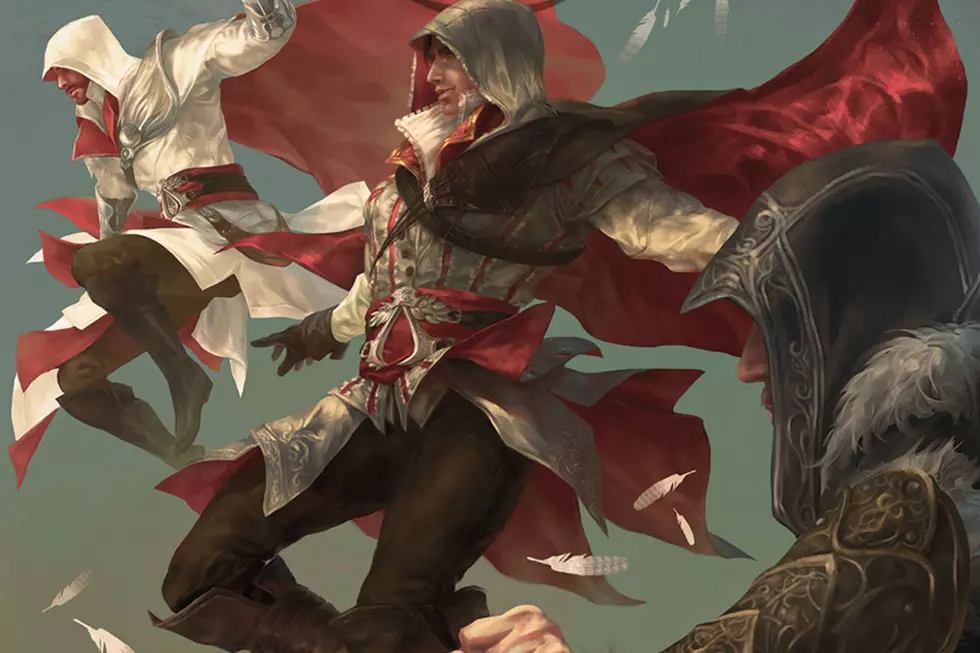
‘Assassin’s Creed: The Fall’ #1 & ‘Dungeons and Dragons’ #1: No, Really, They’re Pretty Good

I always approach tie-in comics with an element of suspicion. Even when the comic in question is connected to an existing fictional universe that was designed as a story first and foremost, and has pre-existing, likable characters -- something like Farscape or Doctor Who or Metalocalypse or Fraggle Rock -- I'm not initially hopeful that it will to live up to the source material, often out fear that it will be a hastily thrown together cash-grab meant to take more money from loyal fans of the franchise.
And so not only was this week's first issue of Assassin's Creed: The Fall was a pleasant surprise, and I was even more surprised by another licensed book, IDW's new Dungeons and Dragons series, which you would expect to be a completely phoned in book that's only read by diehard D&D fans who failed their intelligence checks. The thing is, apparently no one told writer John Rogers and artist Andrea Di Vito that, and as a result Dungeons and Dragons is way more fun than it has any right to be.When I first heard that the Assassin's Creed video game series was getting its own comic, my expectations were not high, at least until I heard the creative team involved Cameron Stewart, creator of the Eisner-winning webcomic Sin Titulo and artist on such projects as Batman and Robin and Seaguy with Grant Morrison, and Karl Kerschl, creator of the Eisner-nominated webcomic The Abominable Charles Christopher and artist on several DC projects.
I will admit that if any video game has the right ingredients to work as a comic, it's Assassin's Creed. If you haven't played any of the games,they tell the story of a centuries old conflict between the Templars, a secret organization controlling the world from behind the scenes and seeking to impose order at any cost, and the Assassins, a small group of highly-trained killers who use sophisticated weaponry and ye olde parkoure to strike against the Templars in order to preserve individual freedoms.
The main character exists in the present day, but uses a machine to re-experience the lives (and missions) of his Assassin ancestors in order to learn things ranging from nifty ways to kill people, to key facts about secret world history and ancient high-tech artifacts. It manages to pull in just about every key figure or group from historical conspiracy theories along the way, from the Templars to Tesla to Leonardo DaVinci to Jesus Christ to Houdini, and I'm going to stop there because some of you already have secret history bingo at this point.
I skipped the first game in the series but played the second, in which I got to play as a gentleman named Ezio who is Renaissance Batman and also Renaissance Spider-Man and also straight up kills people and at one point has a climactic fistfight with the Pope in the secret high-tech sub-level under the Vatican. I did not make any of that up and that is why Assassin's Creed 2 is one of my favorite current generation video games.

Because the series has the whole of history to play with, Kerschl and Stewart aren't limited to times, places and characters we've seen before, and they make good use of that freedom. The story is still framed around a modern character having flashbacks to an ancestor's life, but rather than taking you to the Holy Land of the Crusades or Renaissance Italy, the comic follows Daniel, a down-on-his luck recovering junkie living in the last years of the 20th century, and his flashbacks to Nikolai Orelov, an Assassin living in 1880s Russia tasked with killing the Tsar.
Both Daniel and Nikolai find themselves in over their heads and are troubled by grief about their past. Daniel can't seem to get over the fact that he bears some responsibility for getting his girlfriend killed, and Nikolai is plagued by doubt and guilt over family members who were killed in their previous attempts to assassinate the Tsar, even as he attempts make the same attempt himself.
The comic reads a little differently depending on how familiar you are with the game, and while the book is accessible to new readers, I imagine it's going to appeal more to people who are fans of the series already. The first issue of the three issue series leaves many questions unanswered, and still little is known about the pasts of Daniel and Nikolai and how they've come to be where they are. But Kerschl and Stewart set the mood and capture the tone of the games while finding their own story to tell within its world.

N onetheless, my favorite comic coming out of a licensed property this week is somehow Dungeons and Dragons #1, written by John Rogers with art by Andrea Di Vito and colors by Aburtov and Graphikslava. Dungeons and Dragons is not a property that has been blessed with adaptations into other media that could be considered "good" in the traditional sense of the word. Sure, we all have fond memories of the Saturday morning cartoon about the kids who went to a fantasy world after riding a magic roller coaster. Or something, I wasn't clear on that. And yes, there was that movie where Marlon Wayans and that guy who played Jimmy Olsen in Lois and Clark fought Jeremy Irons and also dragons. But most of those works were not being intentionally funny. This, on the other hand, is.
And it works. Rogers' dialogue is great fun to read. He manages to take the stock parts of snarky warrior lead hero, gruff dwarf, haughty elf, kleptomaniac halfling thief and sexy half-demon wizard and develop them all into interesting characters in the span of a single issue, largely through their interaction with each other and with the people they encounter as they're arrested, cleared, and finally tasked with finding the source of large-scale demonic possessions plaguing the town that had the nearest convenient tavern.
If you've ever sat down for a none-too-serious pen and paper RPG session with friends, you should strongly consider giving this book a try. If you've ever enjoyed a lighthearted fantasy adventure with plenty of action and comic relief, you should probably give this book a try. If you've been reading Image Comics' Skullkickers you probably give this book a try, because while the visuals are not as striking the writing and the characters are much stronger. And if you want to read a comic that features a beret wearing Gnome wizard with a handlebar mustache named Copernicus Jinx, who also happens to have one arm made of metal, you should definitely give this comic a try because that's not something I see happening with great frequency in any other book on the shelves.

More From ComicsAlliance

![Batgirl’s Latest DC Collectibles Figure Cements Her Status as a DC Icon [Review]](http://townsquare.media/site/622/files/2017/02/IMG_1606.jpg?w=980&q=75)
![Requiescat In Pace: Ezio Returns In ‘Assassin’s Creed: Reflections’ #1 [Preview]](http://townsquare.media/site/622/files/2017/02/ACFeat.png?w=980&q=75)
![Unknown Assasins Strike In ‘Assassin’s Creed: Uprising’ #1 [Preview]](http://townsquare.media/site/622/files/2017/01/ASSASSINS_CREED_UPRISING_1_Featured.jpg?w=980&q=75)

![‘Gotham Academy: Second Semester’ #5 Proves That Smoke Bombs Are The Solution To All Your Teen Problems [Exclusive Preview]](http://townsquare.media/site/622/files/2017/01/GA00.jpg?w=980&q=75)



